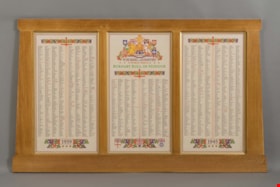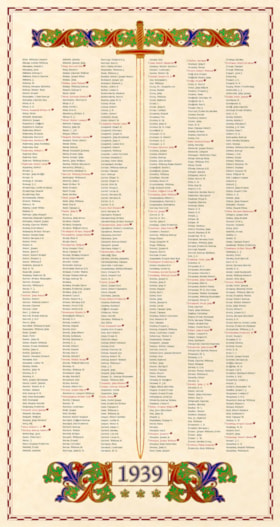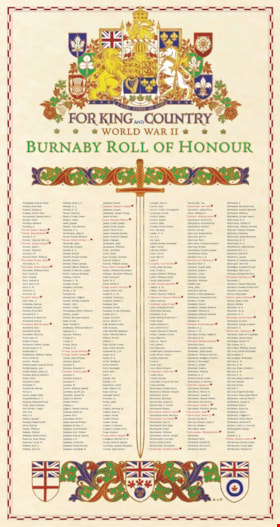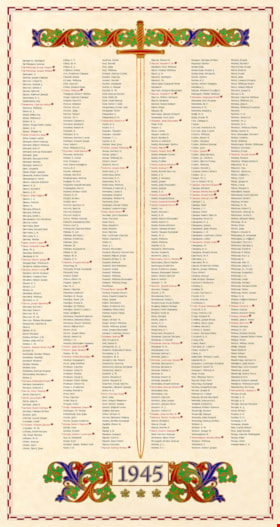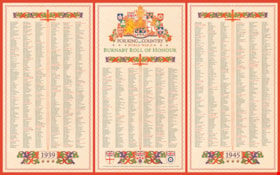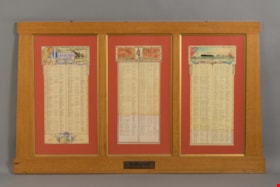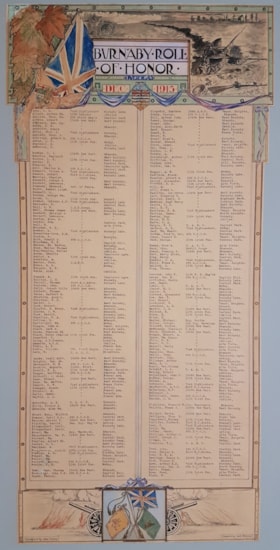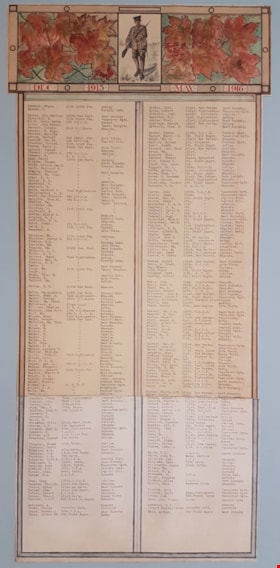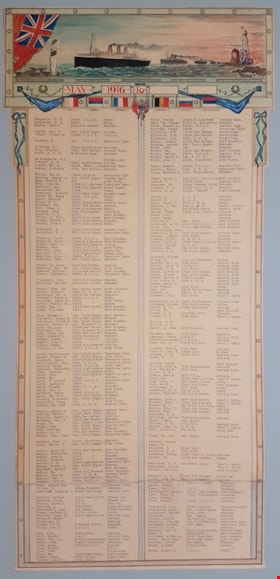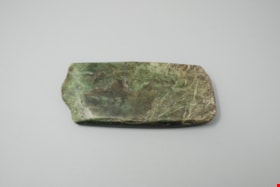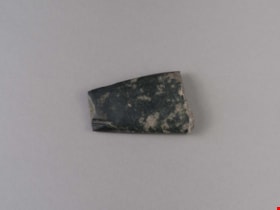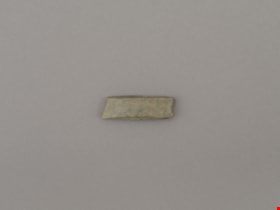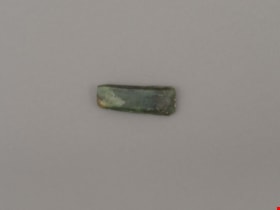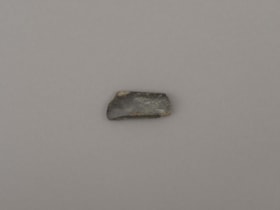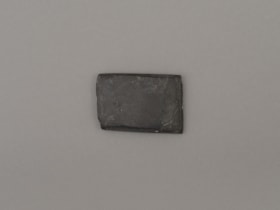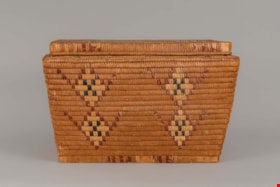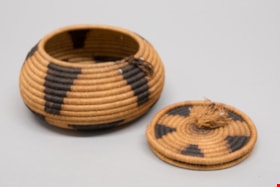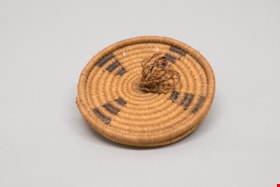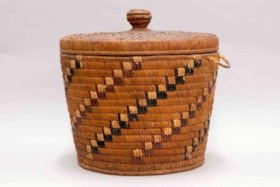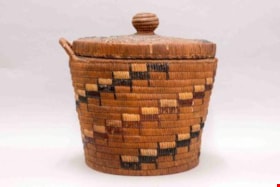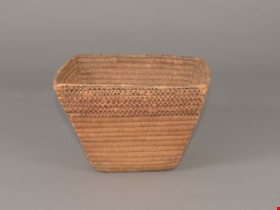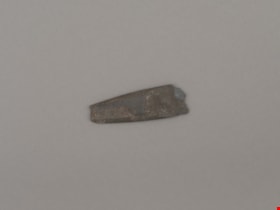More like 'Interview with Toki Miyashita by Rod Fowler February 27, 1990 - Track 1'
Narrow Results By
Subject
- Archeological Specimen 33
- Armament 18
- Container 13
- Container - Baskets 13
- Emergency Measures - Civil Defence 3
- Food Service Tools and Equipment 1
- Indigenous peoples - British Columbia 55
- Persons 55
- Transportation 1
- Wars - World War, 1914-1918 1
- Wars - World War, 1939-1945 4
- Weights and Measurements Tools and Equipment 2
honour roll
https://search.heritageburnaby.ca/link/museumartifact79416
- Repository
- Burnaby Village Museum
- Accession Code
- X2834
- Description
- Roll of Honor for soldiers in World War II who came from Burnaby; large wooden tripartate frame with typed lists of names in each panel. "Burnaby Roll of Honour World War II". The honour roll and frame was made in 2005 by the request of the Heritage Commission.
- Object History
- Honour rolls that recognize individuals that serve in the time of war have been used by communities throughout Canada and the Commonwealth as a traditional act of remembrance. These memorials consist of a list of veterans that is compiled to ensure that names of all service men and women are included, with their rank and service acknowledged. The "Heroic Dead" have been traditionally marked on Canadian honour rolls with the addition of a cross and/or maple leaf beside the honoured name. Typically this sombre memorial is crafted in traditional style using calligraphy for the names listed on the "tablets" and native woods and brass for the frame materials. Burnaby has a proud history of men and women who served by volunteering for active service. The community honoured its war heroes during World War I with an impressive Honour Roll crafted by civic staff and dedicated at the former Municipal Hall at Edmonds on July 14, 1916. The intention of this memorial was to "keep the record bright before the people of the municipality". At the conclusion of this war over 1,200 names of service men and women were listed including over 90 "Heroic Dead" who paid the "ultimate sacrifice". The Burnaby Honour Roll (BV004.54.1) remained as an important civic memorial on public display in the old municipal hall and was the focus of many annual Remembrance Day services. It consisted of a wooden frame with three paper "rolls."
- Country Made
- Canada
- Province Made
- British Columbia
- Site/City Made
- Burnaby
- Subjects
- Wars - World War, 1939-1945
Images
Documents
newsletter
https://search.heritageburnaby.ca/link/museumartifact39839
- Repository
- Burnaby Village Museum
- Accession Code
- BV999.17.14
- Description
- Newsletter, "The Burnaby Warden's Gazette"; editor "J. Allbuary Clou"; c. 1940s; mimeographed page; paper is yellowed
- Object History
- Newsletter was referred to by Harry Charles Cutress who was a member of the Burnaby Air Raid Precautions in South Burnaby during the 1940s.
- Category
- 08. Communication Artifacts
- Classification
- Documentary Artifacts - - Other Documents
- Object Term
- Serial
- Country Made
- Canada
- Province Made
- British Columbia
- Site/City Made
- Burnaby
- Publication Date
- [194-]
Images
Documents
newsletter
https://search.heritageburnaby.ca/link/museumartifact39840
- Repository
- Burnaby Village Museum
- Accession Code
- BV999.17.15
- Description
- "Burnaby Civil Gazette Defence", "Office of the Controller"; "Nov.-Dec. 1943", "Edmonds, B.C."; "Cutress, H." "3724 Rumble St."; paper is yellowed; 2 pages doubled sided; mimeographed
- Object History
- Newsletter is addressed to Harry Charles Cutress who was an active member of the Burnaby Air Raid Precautions in South Burnaby.
- Category
- 08. Communication Artifacts
- Classification
- Documentary Artifacts - - Other Documents
- Object Term
- Serial
- Country Made
- Canada
- Province Made
- British Columbia
- Site/City Made
- Burnaby
- Title
- Burnaby Civil Defence Gazette
- Publication Date
- Nov-Dec 1943
Images
Documents
syllabus
https://search.heritageburnaby.ca/link/museumartifact39841
- Repository
- Burnaby Village Museum
- Accession Code
- BV999.17.16
- Description
- Page, "Burnaby Warden Service" "Syllabus of Training" "Nov. 1/43 - Mar. 30/44"; one page printed both sides
- Object History
- Syllabus belonged to Harry Charles Cutress who was a volunteer with the Burnaby Air Raid Precautions service in South Burnaby during the 1940s.
- Category
- 08. Communication Artifacts
- Classification
- Documentary Artifacts - - Instructional Documents
- Object Term
- Syllabus
- Publication Date
- November 1-March 30, 1944
Images
Documents
honour roll
https://search.heritageburnaby.ca/link/museumartifact47246
- Repository
- Burnaby Village Museum
- Accession Code
- BV004.54.1
- Description
- Roll of Honor [sic]; 1916; Burnaby; large wooden tripartate frame with typed lists of names in each panel; left list "Burnaby Roll of Honour / Dec. 1915"; centre list "Dec. 1915 May 1916"; right list "May 1916"; watercolour images of war at top of each list; "The Great War" on brass plaque bottom centre.
- Object History
- Honour rolls that recognize individuals that serve in the time of war have been used by communities throughout Canada and the Commonwealth as a traditional act of remembrance. These memorials consist of a list of veterans that is compiled to ensure that names of all service men and women are included, with their rank and service acknowledged. The "Heroic Dead" have been traditionally marked on Canadian honour rolls with the addition of a cross and/or maple leaf beside the honoured name. Typically this sombre memorial is crafted in traditional style using calligraphy for the names listed on the "tablets" and native woods and brass for the frame materials. Burnaby has a proud history of men and women who served by volunteering for active service. The community honoured its war heroes during World War I with an impressive Honour Roll crafted by civic staff and dedicated at the former Municipal Hall at Edmonds on July 14, 1916. The intention of this memorial was to "keep the record bright before the people of the municipality". At the conclusion of this war over 1,200 names of service men and women were listed including over 90 "Heroic Dead" who paid the "ultimate sacrifice". The Burnaby Honour Roll remained as an important civic memorial on public display in the old municipal hall and was the focus of many annual Remembrance Day services. It consisted of a wooden frame with three paper "rolls." The Honour Roll unit was removed from the old municipal hall in 1956 when municipal council chambers and offices were relocated to the 4949 Canada Way hall site. It languished in storage and obscurity for decades until being "rediscovered" by a city works crew in 1993 and relocated to Burnaby Village Museum. It was professionally conserved by museum staff and in 2004 was placed in secure storage at the Museum. In 2005, the Heritage Commission approved a project that would provide a World War II Honour Roll to compliment the first one from 1916. The Government of Canada declared 2005 the "Year of the Veteran" so the City decided to create the new World War II honour roll by November 11, 2005 (Accession number X2834). It was determined that no complete Honour Roll of Burnaby's contribution to World War II yet existed. The research and creatin was completed so that both honour rolls could be displayed in City Hall in 2005. The intention was set that both honour rolls would be stored at the Museum and exhibited at City Hall during the month of November as part of the City's commemoration.
- Marks/Labels
- BURNABY / ROLL / OF HONOR", hand lettered in black ink, title at top of first panel. "DEC. 1915"/ May 1916", hand lettered in red ink at top of first panel. "DEC 1915 / MAY 1916", hand lettered in red at top of second panel. "MAY 1916", handlettered at top of third panel. "Designed by John Dunlop", handlettered in lower left corner of first panel "Compiled by Jack Browne", handlettered in lower right corner of first panel "THE GREAT WAR", etched into brass plaque in centre of bottom frame cross bar
- Country Made
- Canada
- Province Made
- British Columbia
- Site/City Made
- Burnaby
- Subjects
- Wars - World War, 1914-1918
Images
Documents
adze blade
https://search.heritageburnaby.ca/link/museumartifact44868
- Repository
- Burnaby Village Museum
- Accession Code
- BV002.57.19
- Description
- Nephrite adze blade; chipped on one end; rectangular shaped.
- Object History
- The donor inherited this artifact from his mother, Katherine Maude (Kitty) Peers, who inherited them from her father, Louis Claude Hill. The artifacts were found on his farm, Brookfield Farm, at Douglas Road and Sperling Avenue (now site of Burnaby Village Museum).
- Nephrite is found in the Fraser Canyon
- Culture Phase: Possibly Locarno Beach phase (3520-2200 Before Present) or Marpole (400BC - 400AD)
- Historic Neighbourhood
- Burnaby Lake (Historic Neighbourhood)
Images
Documents
adze blade
https://search.heritageburnaby.ca/link/museumartifact44870
- Repository
- Burnaby Village Museum
- Accession Code
- BV002.57.21
- Description
- Chisel, adze or axe blade made of serpentine; black; ends broken off; tapered rectangle shape.
- Object History
- The donor inherited this artifact from his mother, Katherine Maude (Kitty) Peers, who inherited them from her father, Louis Claude Hill. The artifacts were found on his farm, Brookfield Farm, at Douglas Road and Sperling Avenue (now site of Burnaby Village Museum).
- Culture Phase: Locarno Beach (3520-2200 Before Present) or Marpole (400BC - 400AD)
- Historic Neighbourhood
- Burnaby Lake (Historic Neighbourhood)
Images
Documents
adze blade
https://search.heritageburnaby.ca/link/museumartifact44872
- Repository
- Burnaby Village Museum
- Accession Code
- BV002.57.23
- Description
- Chisel, adze or axe blade made of serpentine; small
- Object History
- The donor inherited this artifact from his mother, Katherine Maude (Kitty) Peers, who inherited them from her father, Louis Claude Hill. The artifacts were found on his farm, Brookfield Farm, at Douglas Road and Sperling Avenue (now site of Burnaby Village Museum).
- Culture Phase: Locarno Beach (3520-2200 Before Present) or Marpole (400BC - 400AD)
- Historic Neighbourhood
- Burnaby Lake (Historic Neighbourhood)
Images
Documents
adze blade
https://search.heritageburnaby.ca/link/museumartifact44873
- Repository
- Burnaby Village Museum
- Accession Code
- BV002.57.24
- Description
- Nephrite adze blade; small
- Object History
- The donor inherited this artifact from his mother, Katherine Maude (Kitty) Peers, who inherited them from her father, Louis Claude Hill. The artifacts were found on his farm, Brookfield Farm, at Douglas Road and Sperling Avenue (now site of Burnaby Village Museum).
- Nephrite is found in the Fraser Canyon
- Culture Phase: Locarno Beach (3520-2200 Before Present) or Marpole (400BC - 400AD)
- Historic Neighbourhood
- Burnaby Lake (Historic Neighbourhood)
Images
Documents
adze blade
https://search.heritageburnaby.ca/link/museumartifact44874
- Repository
- Burnaby Village Museum
- Accession Code
- BV002.57.25
- Description
- Adze blade; small; possibly nephrite.
- Object History
- The donor inherited this artifact from his mother, Katherine Maude (Kitty) Peers, who inherited them from her father, Louis Claude Hill. The artifacts were found on his farm, Brookfield Farm, at Douglas Road and Sperling Avenue (now site of Burnaby Village Museum).
- Nephrite is found in the Fraser Canyon
- Culture Phase: Locarno Beach (3520-2200 Before Present) or Marpole (400BC - 400AD)
- Historic Neighbourhood
- Burnaby Lake (Historic Neighbourhood)
Images
Documents
adze blade
https://search.heritageburnaby.ca/link/museumartifact44876
- Repository
- Burnaby Village Museum
- Accession Code
- BV002.57.27
- Description
- Nephrite adze blade; rectangular; chipped on one side; slightly grooved on longer edges.
- Object History
- The donor inherited this artifact from his mother, Katherine Maude (Kitty) Peers, who inherited them from her father, Louis Claude Hill. The artifacts were found on his farm, Brookfield Farm, at Douglas Road and Sperling Avenue (now site of Burnaby Village Museum).
- Nephrite is found in the Fraser Canyon
- Marpole Culture (400BC - 400AD) or Gulf of Georgia Culture (400 AD – 1800); essentially these archaeological materials date to the last 2400 years.
- Historic Neighbourhood
- Burnaby Lake (Historic Neighbourhood)
Images
Documents
basket
https://search.heritageburnaby.ca/link/museumartifact17681
- Repository
- Burnaby Village Museum
- Accession Code
- HV978.2.13
- Description
- Nut-shaped, coiled cedar root basket with cedar root foundation and watch-spring base and lid construction. Hinged lid is attached with leather ties. Covered in beading, where in the decorative elements are laid flat on surface, rather than folded into cedar root stitches as is done with imbrication. Designs are in red and black dyed cherry bark. Interior Salish: Nlaka’pamux
- Object History
- Nut-shaped baskets are identified as one of the oldest types by Haeberlin and Teit (1928: 202-3). They were used for storing berries and were also common work baskets for women, used to hold small tools – awls, thread, shells, trinkets and other odds and ends (202).
- Country Made
- Canada
- Province Made
- British Columbia
- Culture
- Nlaka'pamux
Images
Documents
basket
https://search.heritageburnaby.ca/link/museumartifact27529
- Repository
- Burnaby Village Museum
- Accession Code
- HV974.119.3
- Description
- Rectangular coiled cedar root basket with cedar slat foundation, lid has parallel slat construction and is covered with beaded designs edged by imbrication in canary grass. Basket has a flat lid that is hinged to body with leather ties. A mistake was made in how the design was applied to one end of this basket. This is not common as many weavers would correct this mistake. Completely imbricated walls, beaded design on lid. Coast Salish: Sḵwx̱wú7mesh?
- Object History
- The donor reported that the baskets were traded in the early 1920s for clothes by the donor's mother, who lived in North Vancouver. Her mother told her the "Capilano Indians" used to go door to door with their baskets in North Vancouver.
- Diamonds are considered a star pattern and are common to Sḵwx̱wú7mesh and Nlaka’pamux basketry. The main design resembles a ladder or fence and is uncommon.
- Country Made
- Canada
- Province Made
- British Columbia
- Culture
- Sḵwx̱wú7mesh
Images
Documents
basket
https://search.heritageburnaby.ca/link/museumartifact30051
- Repository
- Burnaby Village Museum
- Accession Code
- HV973.79.1
- Description
- Rectangular coiled cedar root basket with cedar slat foundation. Parallel slat base and lid. Walls of basket flare slightly towards the rim. Basket has a conoid lid – one that fits over top of a flange on the rim of the basket. Rim is inset. Sets of triangular shaped stitches attach base to walls. Base of basket is protected by a foot, one slat high. Grass used for imbricated designs has a flat appearance typical of cattail grass. Black dyed and red cherry bark used for other design elements. Handles missing.
- Object History
- Design variant is uncommon. This may be a zoomorphic design possibly representing an animal head or flying bird.
- Country Made
- Canada
- Province Made
- British Columbia
- School/Style
- Coast Salish
Images
Documents
basket
https://search.heritageburnaby.ca/link/museumartifact50308
- Repository
- Burnaby Village Museum
- Accession Code
- BV006.24.5
- Description
- The basket is round with a lid and has a geometric design in black. Made using the coiled method.
- Object History
- Resembles California and Southwestern style baskets made of willow, dye and grass.
- Country Made
- United States of America
- Province Made
- California
Images
Documents
basket lid
https://search.heritageburnaby.ca/link/museumartifact50309
- Repository
- Burnaby Village Museum
- Accession Code
- BV006.24.6
- Description
- The basket is round with a lid and has a geometric design in black. Made using the coiled method.
- Object History
- Resembles California and Southwestern style baskets made of willow, dye and grass.
Images
Documents
basket with lid
https://search.heritageburnaby.ca/link/museumartifact87630
- Repository
- Burnaby Village Museum
- Accession Code
- BV017.11.3
- Description
- basket with lid; First Nations basket with lid; The basket is round, with two handles opposite each other. The handles are wrapped twine. The wrapping is missing from one handle. The lid has a knob handle in the centre. Basket and lid are decorated with a dark and light spiraling pattern. Had been used for storing knitting.
- Object History
- The basket was acquired by the donor's grandparents, Matilda and Robert William Handel, when they were living in North Vancouver. They were made by one of the local First Nations weavers, name unknown.
- Measurements
- Approx. H: 32 cm Dia.: 34 cm
- Culture
- ʷməθkʷəy̓əm (Musqueam)
Images
Documents
basket with lid
https://search.heritageburnaby.ca/link/museumartifact87633
- Repository
- Burnaby Village Museum
- Accession Code
- BV017.11.4
- Description
- basket with lid; First Nations basket with lid; The basket is round, with a single handle (opposite handle is missing). The lid has a knob handle in the centre. Basket and lid are decorated with a dark and light spiraling pattern. Had been used for storing knitting.
- Object History
- The basket was acquired by the donor's grandparents, Matilda and Robert William Handel, when they were living in North Vancouver. They were made by one of the local First Nations weavers, name unknown.
- Measurements
- Approx. H: 37 cm Dia.: 36 cm
- Culture
- ʷməθkʷəy̓əm (Musqueam)
Images
Documents
berry basket
https://search.heritageburnaby.ca/link/museumartifact27527
- Repository
- Burnaby Village Museum
- Accession Code
- HV974.119.1
- Description
- Trapezoidal shaped, coiled cedar root basket with cedar slat foundation. Finished with an overcast rim with root foundation. Design elements missing from one side of the basket, which is uncommon but has been seen on cradles from the Mount Currie area (Interior Salish: Lil'wat). It was perhaps the side that rests on the wearer's back. Steeply angled sides.
- Coast Salish: Sḵwx̱wú7mesh? Interior Salish: Stl’atl’imx: Lil’wat?
- Object History
- The donor reported that the baskets were traded in the early 1920s for clothes by the donor's mother, who lived in North Vancouver. Her mother told her the "Capilano Indians" used to go door to door with their baskets in North Vancouver.
- Design elements missing from one side of the basket – possibly the side that would have rested against the owner’s back.
- Steeply angled sides keep berries from crushing those at bottom of basket. Work baskets have sides that are more rounded.
- Baskets like these were used with a woven tumpline (wool strap) that was worn against the forehead, while basket was carried on back.
- Country Made
- Canada
- Province Made
- British Columbia
- Culture
- Stl’atl’imx
Images
Documents
blade or projectile
https://search.heritageburnaby.ca/link/museumartifact44879
- Repository
- Burnaby Village Museum
- Accession Code
- BV002.57.30
- Description
- Ground slate point
- Object History
- The donor inherited this artifact from his mother, Katherine Maude (Kitty) Peers, who inherited them from her father, Louis Claude Hill. The artifacts were found on his farm, Brookfield Farm, at Douglas Road and Sperling Avenue (now site of Burnaby Village Museum).
- Culture Phase: Locarno Beach phase (3520-2200 Before Present)
- Historic Neighbourhood
- Burnaby Lake (Historic Neighbourhood)
